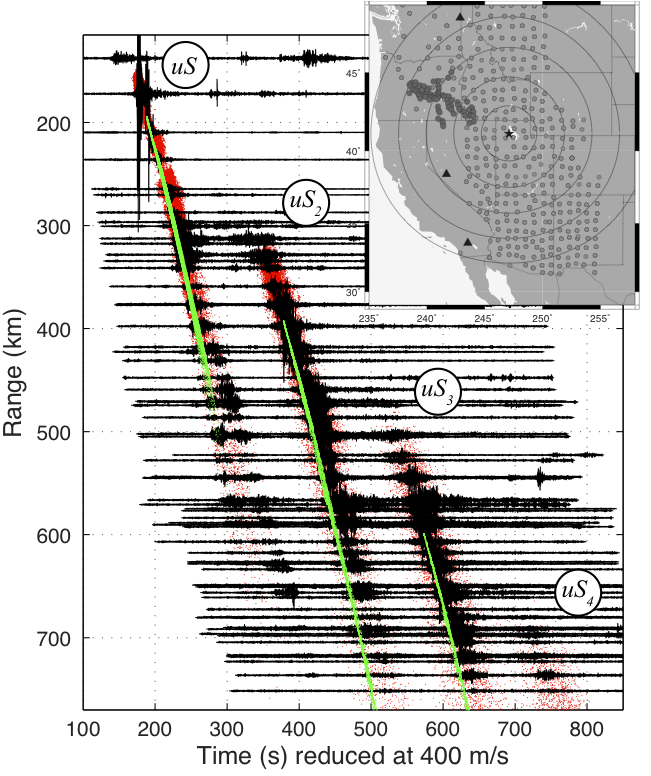2012 IRIS Workshop
A Study of Infrasonic Anisotropy and Multipathing in the Atmosphere Using Seismic Networks
Michael Hedlin:UCSD, Kris Walker:UCSD, Doug Drob:NRL
Atmospheric infrasound from an 18,000 kg explosion in Utah that were recorded by vertical component seismometers in the High Lava Plains network and nearby stations in the USArray Transportable Array (inset). The four branches were ducted through the stratosphere once (uS) to four times (uS4). The green dots represent rays that were shot through a high-resolution atmospheric model. The rays (in red) shot through a model that has added to it a physics-based, stochastic realization of a gravity wave spectrum match the data much more closely. The waveforms were filtered from 0.8 to 3.0 Hz.

Full-resolution graphics file in original format: 0079.ai
Seismometers readily record infrasonic signals from atmospheric sources, presumably through the acoustic-to-seismic coupling phenomenon. For a source located on the Earth’s surface, ray tracing through standard atmospheric models typically predicts a region within 200 km of the source of essentially zero sound pressure due to upward refraction away from the Earth’s surface. Recent research using only a few observations suggests that signals observed well within these “zones of silence” may be due to the interaction of the infrasonic wavefield with time-varying, small-scale structure due to internal gravity waves that are not represented in the larger scale atmospheric models. As shown in the figure, adding a stochastic representation of gravity waves to the standard atmospheric model provides a higher-resolution model that yields a better prediction of the range extent of infrasonic branches in this dense record section. Gravity wave perturbed rays also provide a better match of the temporal dispersion of individual signal wavetrains. These results are significant because they suggest that some of the important common observables in Infrasonics such as travel times, wavetrain duration, and waveform amplitude may be reliably estimated with current atmospheric modeling capabilities using relatively fast ray tracing techniques. Additional active- and passive-source experiments with dense networks of observations are required to test this hypothesis.
Acknoweldgements: We would like to thank Matt Fouch (ASU) and David James (Carnegie Inst.) for providing access to the High Lava Plains (HLP) data and Relu Burlacu (University of Utah) for ground-truth information about the UTTR explosions. The waveform data were obtained from the IRIS-DMC. We would also like to acknowledge NASA’s GMAO for GEOS-5 data and NOAA’s GFS. Support for MAHH and KW was provided by NSF under contract EAR-1053576. Support for DD was provided by SMDC under project nbr. W9113M-06-C-0029.
For further reading: Hedlin, M.A.H., Walker, K., Drob, D. and de Groot-Hedlin, C.D., 2012, Infrasound: Connecting the Solid Earth, Oceans and Atmosphere, Annual Review of Earth and Planetary Sciences, 40, 327-354 doi: 10.1146/annurev-earth-042711-105508
Keywords: infrasound, gravity_waves, zonal_winds, multipathing
